Physical Address
304 North Cardinal St.
Dorchester Center, MA 02124
Surgical refinement of the nasal tip is considered by many to be one of the most challenging components of rhinoplasty. At the heart of the challenge is the need to not only adequately access and visualize but also control the complex three-dimensional architecture of the alar cartilages while being cognizant of tip support mechanisms and postoperative contracture. Although numerous approaches have been described throughout the literature, the endonasal delivery flap technique continues to be a workhorse in the armamentarium of surgical approaches for tip refinement. This chapter will focus on the beauty, versatility, and simplicity of endonasal tip surgery.
Tip rhinoplasty techniques have evolved substantially since Joseph first introduced cosmetic rhinoplasty in the late 1800s. This evolution continues even to this day as discussions on the “ideal” surgical approach for nasal tip contouring ensue. The various incisions commonly used in rhinoplasty and their respective indications are illustrated in Figure 6-1 . Four essential points must be kept in mind when choosing an approach for intermediate to advanced tip maneuvers: (1) the ability to adequately visualize the entire alar complex including all areas of the medial, intermediate, and lateral crura; (2) the ability to modify each alar unit separately and address asymmetries; (3) the ability to maintain or reconstitute tip support mechanisms; and (4) the ability to minimize resection of natural structural elements.
Next, we describe our philosophy, which is based on the creation of the double-dome unit as described by McCollough and English. In our hands, this particular tip-sculpting technique has become a workhorse in tip modification as it nicely fulfills the above criteria. In fact, a 15-year review of the senior author's results with use of the double-dome unit procedure for tip rhinoplasty not only has proved the technique to be reliable with consistent results but also has shown it to carry a low rate of revision. In this chapter, we will first describe our basic surgical technique for endonasal intercartilaginous dome-delivery via the double-dome technique, followed by a review of specific nasal tip deformities and steps utilized to correct these.
It is critical to determine the exact tip deformities before creating a surgical plan. What is the aesthetic problem of the tip and what is one attempting to achieve? This begins with a detailed examination during the consultation period. Standardized forms are helpful for ensuring a complete examination as well as simplifying documentation ( Figure 6-2 ). The tip shape should be described, such as bulbous, twisted , or infantile. Both the degree of rotation and the extent of projection should be evaluated. Skin thickness is critical to assess, and this issue alone may dictate the approach to be taken and/or the procedure to be performed. Palpation is helpful in determining the nature, volume, strength, and resiliency of the lobular cartilages as well as in evaluating tip support. Finally, it is important to note columellar abnormalities and their relation to the alar cartilages.
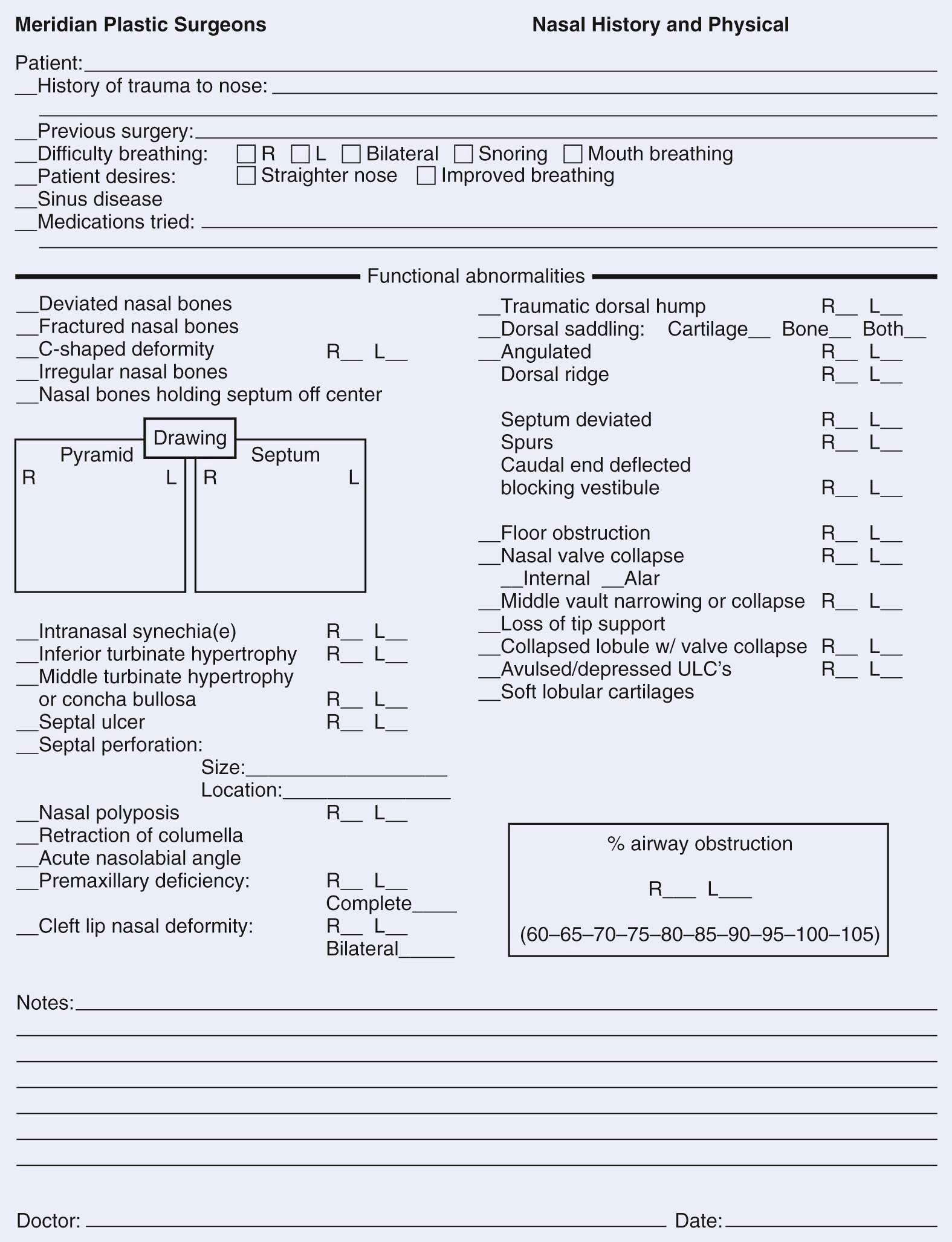
The ideal patient for these techniques has been described by Tardy. The ideal patient has a slightly bifid or broad tip with dual-dome highlights. Thin skin and sparse subcutaneous tissue allow for more refined results from these endonasal techniques. The alar cartilages themselves must be firm and strong. Finally, the alar sidewalls should be thin and delicate, yet resist collapse and recurvature. By using the endonasal delivery approach along with a graduated approach to tip contouring, excellent aesthetic results can be achieved.
There are certain conditions, in our experience, that favor the use of the external columellar approach. It is often difficult to deliver, in a safe and adequate manner, alar cartilages in a patient with scar tissue in the lobule from previous surgery or trauma. Middle nasal vault deformities, in our experience, are more easily corrected through the external columellar approach. Patients with marked asymmetry in the nasal tip, with thin skin and bossa, may require camouflage tip grafting sutured in place. Also, marked twisting of the columella with significant discrepancies between the two medial crura may necessitate the use of an external columellar approach. Other indications for the external approach are extremely soft alar cartilages with no inherent support as well as marked overprojection, overrotation, underprojection, and underrotation of the lobule.
All patients are initially seen in consultation with their selected surgeon. The consult room is designed to put the patient at ease while still maintaining a professional environment. The nasal analysis begins with the patient on a comfortable bar stool in front of a three-way mirror with the physician directly behind him or her. Together they analyze the nose with the physician gently guiding the discussion. The three-way mirror not only allows the patient to get a more accurate view of the three-dimensional qualities of their nose but also relays specific concerns to the surgeon.
An in-depth nasal history is taken during the consult. Inquiries include any previous nasal trauma or surgery, difficulties breathing through the nose, any history of sinus disease or allergies, and present nasal medications. The physician also reviews the more extensive complete history form, which is completed by the patient prior to consultation. An intranasal examination is performed at this time to detect deformities of the septum, enlargement of the turbinates, or other intranasal pathology. A preoperative rhinoplasty form is also completed to document the consultation findings as well as for later reference.
The procedure should be thoroughly discussed at this time and goals summarized with the patient. The physician reviews with the patient what to expect on the day of surgery, including the length of surgery, anesthesia, recovery, and discharge. Initial postoperative care and activity restrictions are also discussed. Finally, the limitations of the surgery, as well as possible complications, are given as part of the informed consent.
The consultation is then continued in the photography suite, where computer imaging is used to illustrate the planned aesthetic endpoint. This allows for confirmation that both the patient and the surgeon agree on the desired goals to be achieved. Following this, a full set of nasal images are taken for preoperative documentation.
The last phase of the consultation is spent with the scheduling nurse, where questions can be answered in what often is a more comfortable setting for the patient. Fees are reviewed with the patient, and signed copies of the procedures and fees are given to the patient. Any necessary lab work is arranged at this time.
Prior to surgery, all patients receive folders with detailed instructions for surgery, prescriptions, and a booklet reviewing postoperative healing and expectations. All patients start an oral antibiotic the day prior to surgery, most often either oral cephalexin (Keflex) or azithromycin (Zithromax), and continue this for 5 days.
At 1.5 hours prior to surgery, patients are administered oral diazepam (Valium), promethazine (Phenergan), metoclopramide (Reglan), and dexamethasone (Decadron) as well as oxymetazoline nasal (Afrin Nasal Sinus) spray. In the operating room, deep sedation, typically using intravenous propofol, is instituted prior to infiltration of the local anesthesia. First, pledgets soaked in 4% cocaine are placed intranasally. After adequate time for decongestion, infiltration is started with 2% lidocaine (Xylocaine) with 1 : 50,000 epinephrine. No more than 7 to 8 mL is injected to minimize volume distortion.
The delivery approach is begun by making either a complete transfixion or a high septal transfixion incision depending on tip projection ( Figure 6-3 ). Curved sharp scissors are then used to dissect up over the anterior superior angle and expose the upper lateral cartilages. Next, intercartilaginous and marginal incisions are made in a standard fashion (see Figure 6-1 ). Thin Metzenbaum scissors are then used to separate the overlying skin from the underlying lower lateral cartilages, nasal domes, and infratip lobule (intermediate crura). Finally, the alar cartilages are delivered with a single hook and supported with Metzenbaum scissors ( Figure 6-4 ). In this fashion, each dome is assessed and recontoured individually.
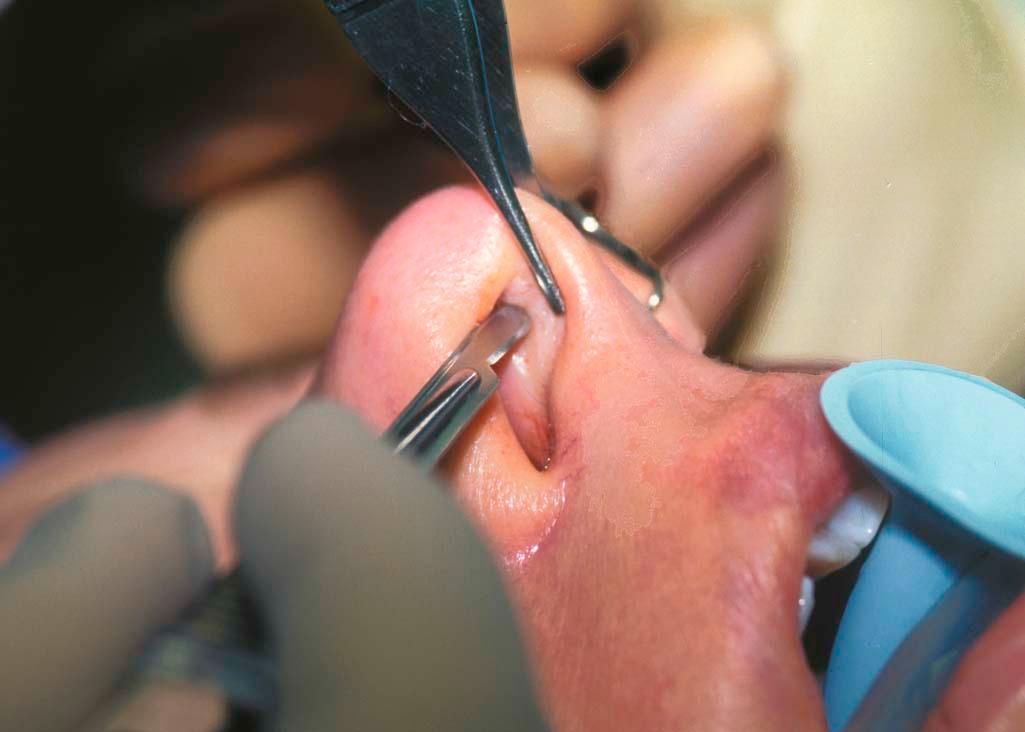
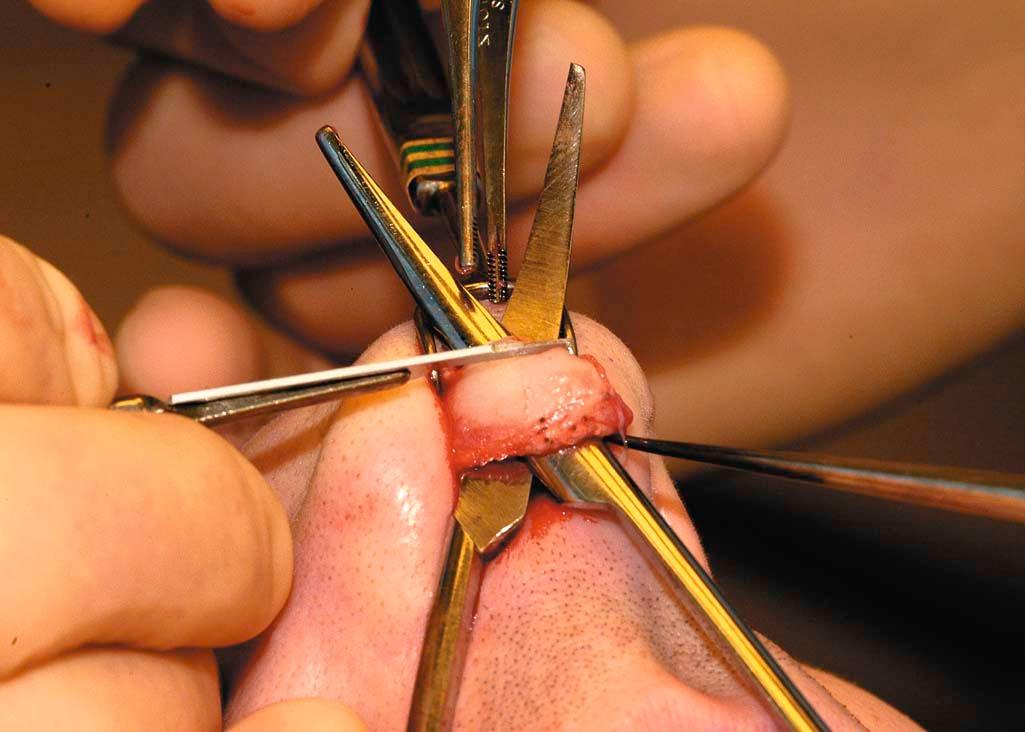
The first step in achieving improved tip definition is the removal of fibrofatty tissue between the domes. This allows greater approximation of the two alar domes. An intact or a complete strip can be performed next by excising the cephalic portion of the lateral crura ( Figure 6-5 ). This achieves both volume reduction and improved supratip definition. It is essential to preserve at least a 7- to 9-mm width of cartilage. In a few select cases, this may be all that is required and the cartilages may be replaced in situ. In most cases, however, other techniques are required to achieve satisfactory tip definition and symmetry.
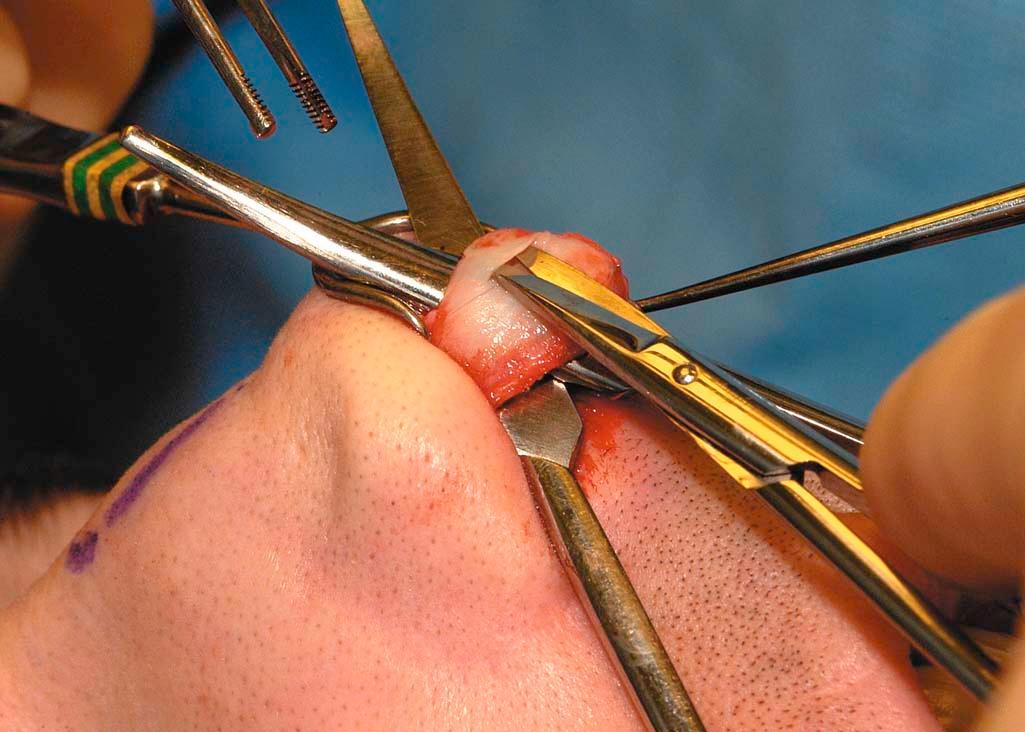
The ideal alar configuration has been described as being when the domal segment is convex, the adjacent lateral crura is slightly concave, and the overlying soft tissue is thin. Occasionally, careful “pinching” of the individual dome cartilages can mold the cartilage into the ideal shape. Most often, however, individual dome treatment with suture is required. Prior to placing the single-dome suture, the vestibular skin is separated from the undersurface of the domal cartilage ( Figure 6-6 ). A 5-0 absorbable synthetic polyglycolic acid (Dexon) mattress suture is placed at the junction of the lateral and medial crura. The knot is tightened to the point where the proper amount of domal definition is achieved ( Figure 6-7 ).
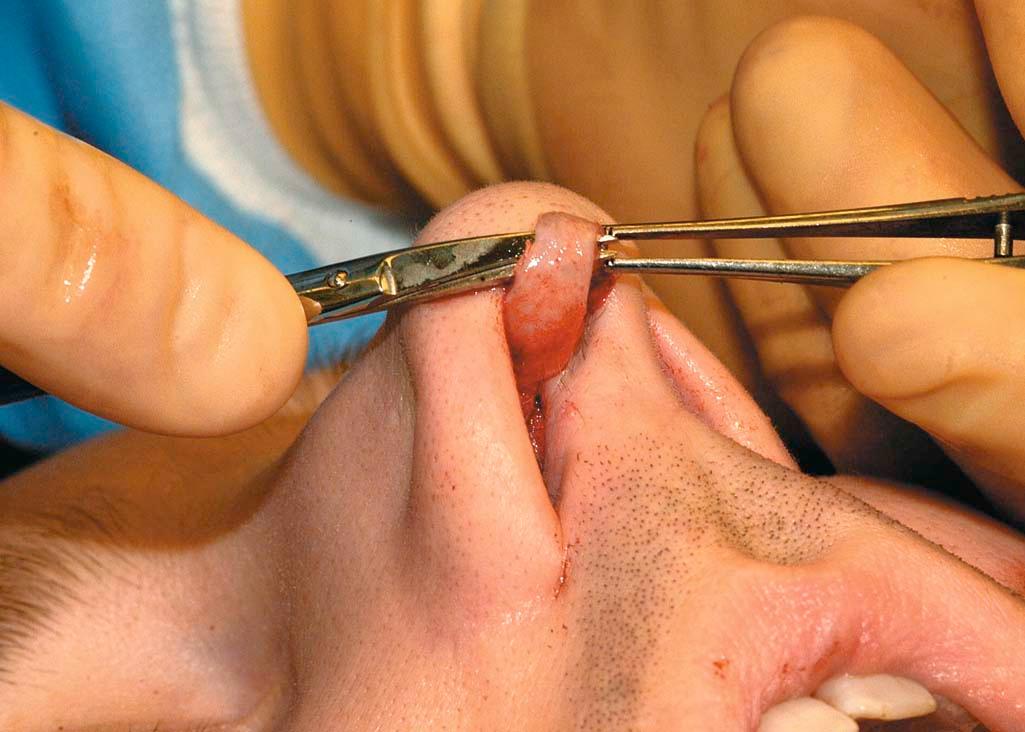
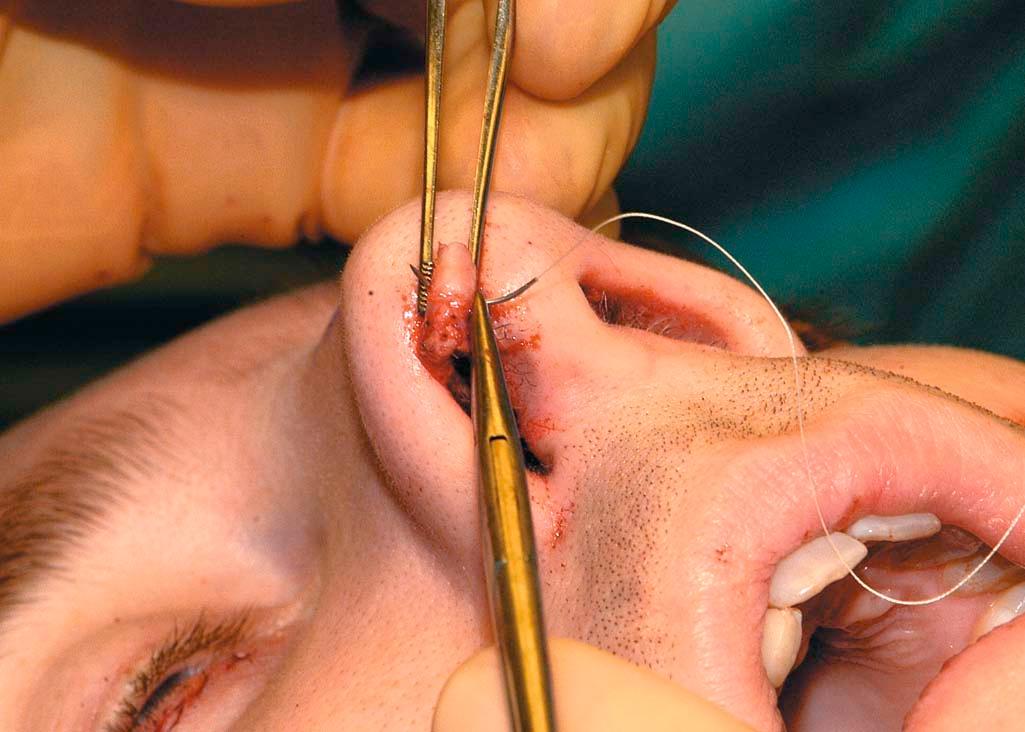
If the individual domes remain asymmetric or improved supratip definition is desired, individual dome trimming can be performed. This involves “beveling” the cephalic portion of the single-dome unit ( Figure 6-8 ).
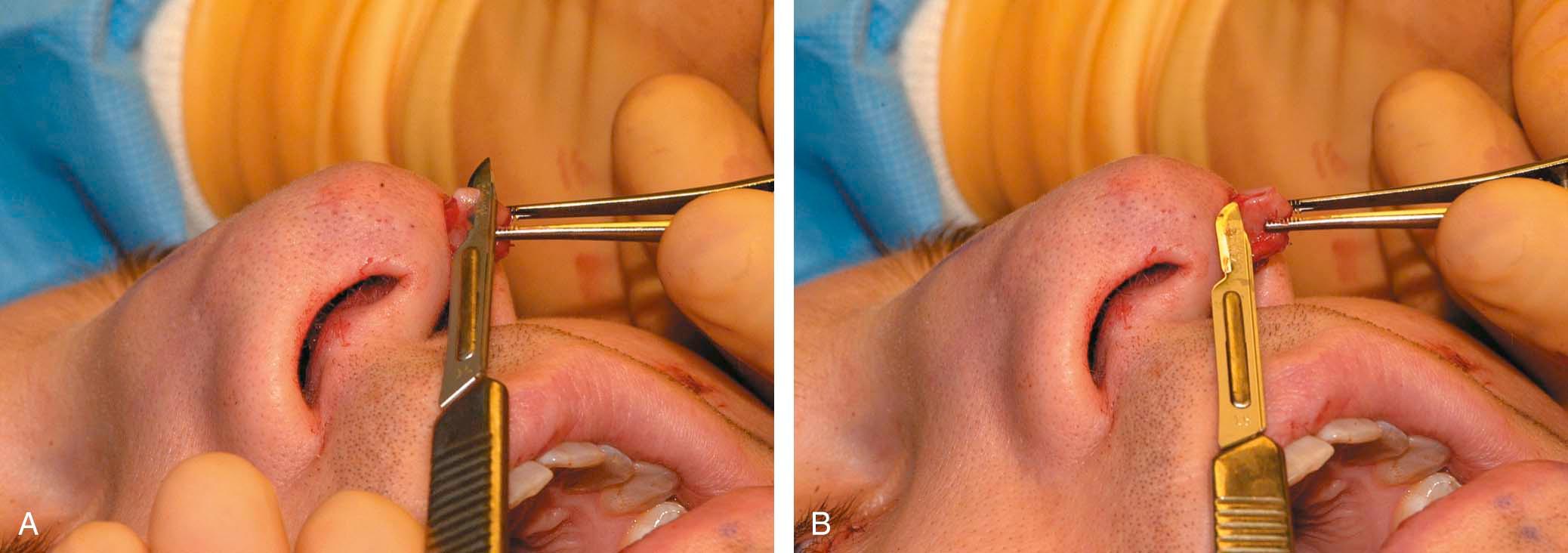
With achievement of symmetric, aesthetically pleasing individual domes, the entire tip is reevaluated. Utilization of the endonasal approach allows this continual critiquing. A double-dome or transdomal mattress suture is next used to bring together the individually defined domes and stabilize these into one unit. Stabilization of the domes is the key to maintenance of long-term results. The suture is placed horizontally through the lateral and medial crura of both domes. We typically use a 5-0 clear polypropylene (Prolene) suture. The desired amount of lobular narrowing can be achieved by altering the tension of the stitch. With the domes replaced, the amount of narrowing can be seen as one tightens the knot ( Figure 6-9 ). It is important to avoid cinching down the suture and creating a unitip appearance.
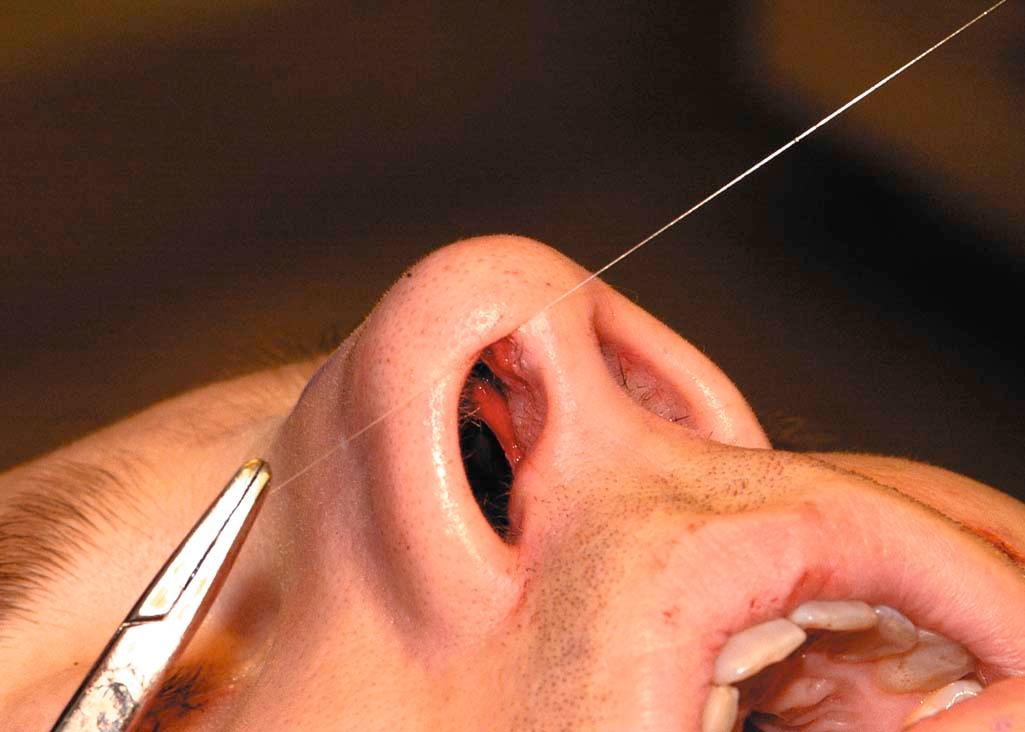
The tip is then reevaluated. At this point, the decision is made on whether more aggressive steps will be required to achieve the desired tip aesthetics. This could include steps such as lateral crural flap, dome division, or the Lipsett maneuver. Marked disparity in length between the two medial crura is best corrected with the Lipsett procedure. With this technique, the lengthier medial crura is delivered and dissected free from its attachments. An appropriate length of crura is resected to achieve equality in length between the medial crura. The two resected ends are then reapproximated with 6-0 monocryl ( Figure 6-10 ). Removing or replacing the double-dome mattress sutures and addressing the anterior-posterior or caudal-cephalic placement of a suture in relation to the other dome may address minor asymmetries.
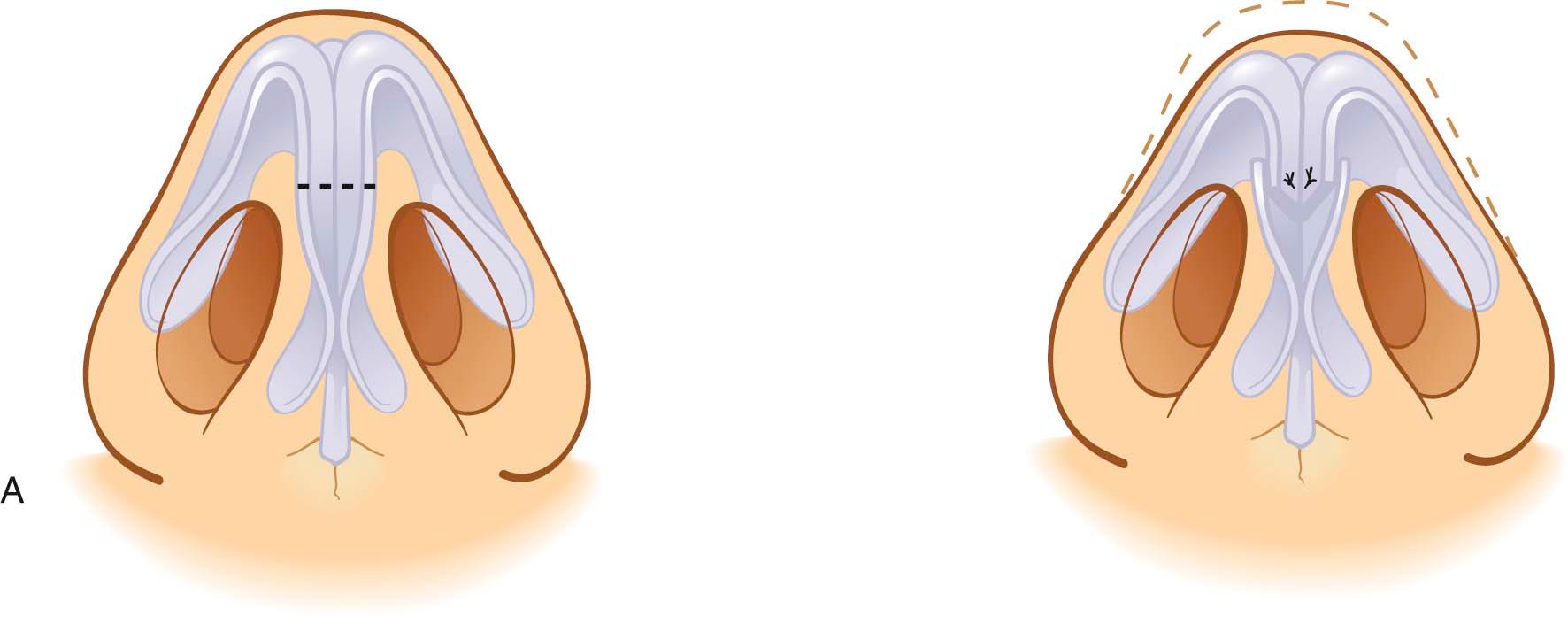
Finally, correction of tip asymmetries may be more easily addressed with dome division, which can be performed medial to the dome, lateral to the dome, or at the mid-point of the dome ( Figure 6-11 ). Dome division is used for a variety of situations when the described more conservative techniques have not been successful. Dome division can allow for more tip narrowing, which is especially required in those with thick skin. Furthermore, it can also be used to achieve upward rotation and increase or decrease tip projection.
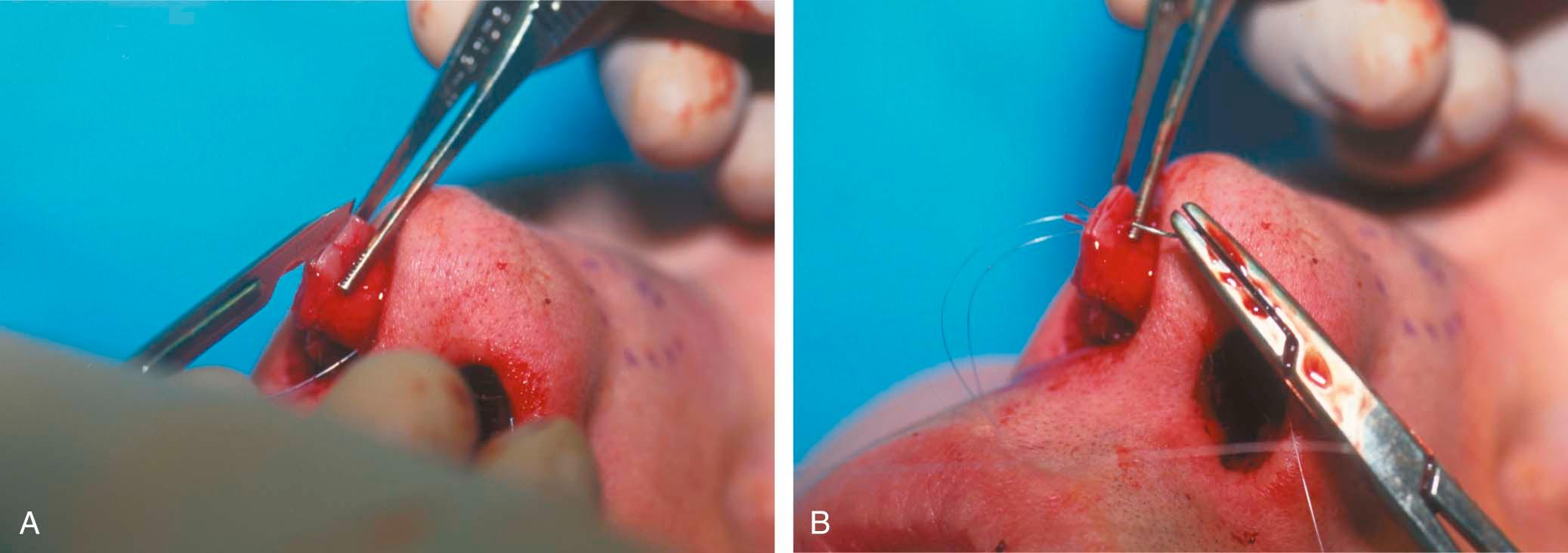
Conservative upward rotation of the tip, on the other hand, is typically achieved by resection of an inverted triangle of caudal septum with corresponding vestibular skin and using a columellar strut to assist in “pushing” the lobule cephalically. If further rotation is required following this, the lateral crural flap technique can be used. This can involve a full incision of the lateral crura or simply a cephalic wedge excision ( Figure 6-12 ). The lateral crura can be overlapped and sutured to shorten their length and create upward rotation.
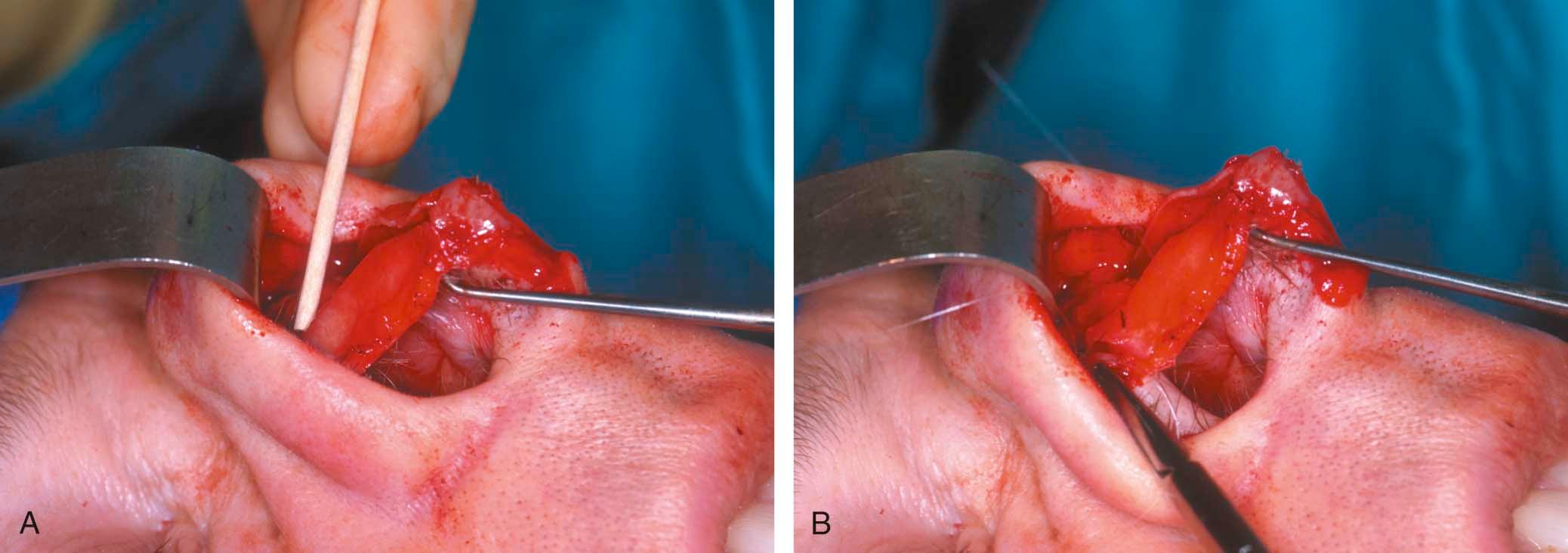
Following achievement of a symmetric and well-defined tip, attention is then turned to the septum, the dorsum and, last, osteotomies. A columellar strut fashioned from septal cartilage is placed between the medial crura and anterior to the nasal spine prior to osteotomies. Intranasal incisions are closed with 5-0 catgut. In closing the marginal incisions, it is important to avoid the lateral crura when suturing. Retraction of the lateral crura could lead to possible alar collapse and nostril asymmetries.
A small rolled piece of absorbable oxidized regenerated cellulose (Surgicel) is placed inside the nose within the vestibule of each newly constructed dome to add stability and prevent hematoma. Tan surgical tape (Micropore) along with an alloy metal splint is used for the external dressing that is removed at 1 week.
Tips that demonstrate minimal deformity and minimally excess width can be addressed in the most conservative fashion. Single-dome suture treatment is often not required in these patients if the alar dome cartilages are delicate, thin, or soft. A conservative cephalic trim followed by a double-dome suture alone can often achieve the desired result ( Figure 6-13 ).
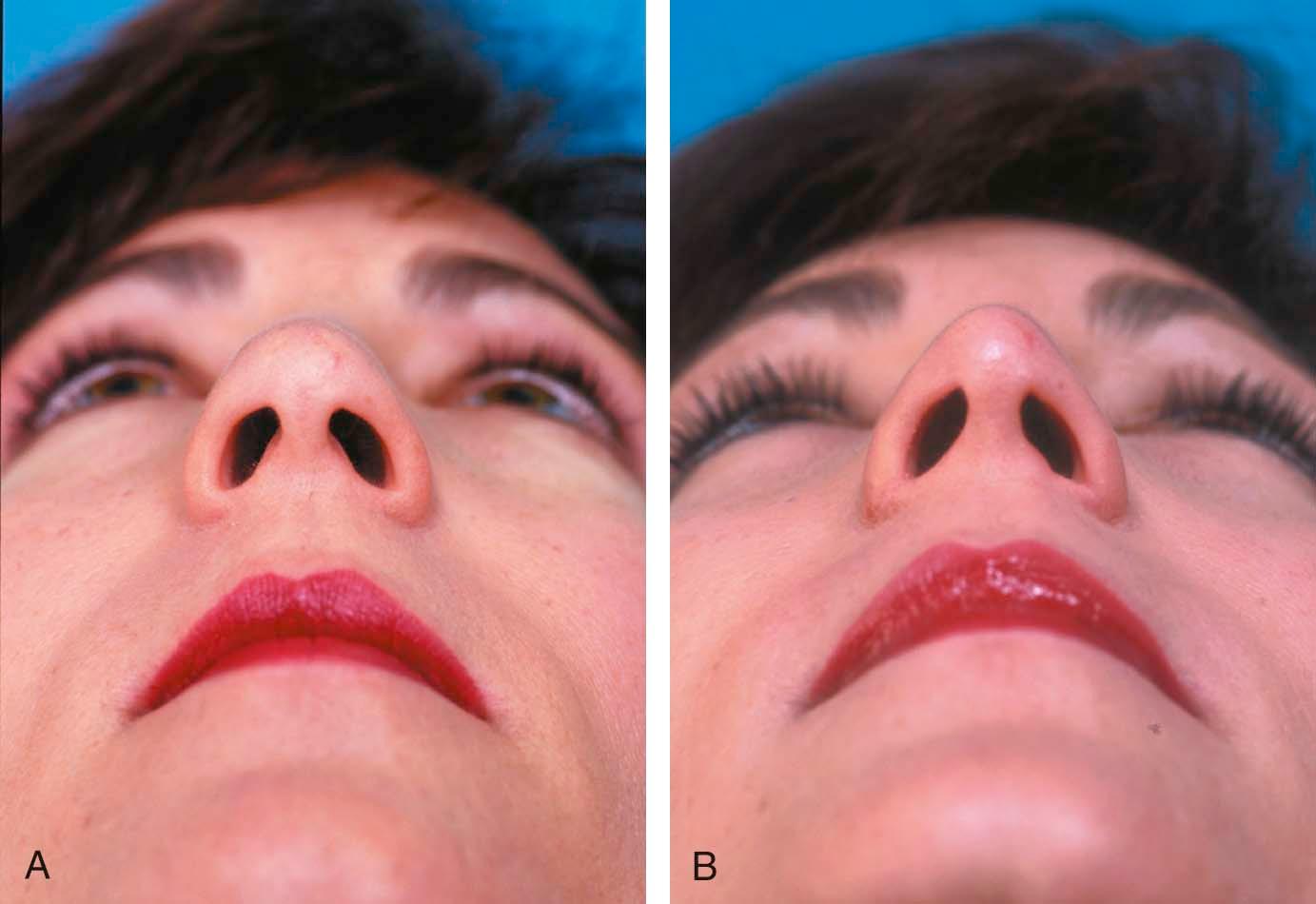
The bulbous tip requires individual treatment of the domes. This is most often addressed with a conservative cephalic trim and an individual single-dome mattress suture. Reconstitution of the double-dome unit with a 5-0 clear Prolene suture completes tip refinement ( Figure 6-14 ). In the case of residual excess width, an alar spanning suture can be used to achieve further narrowing.
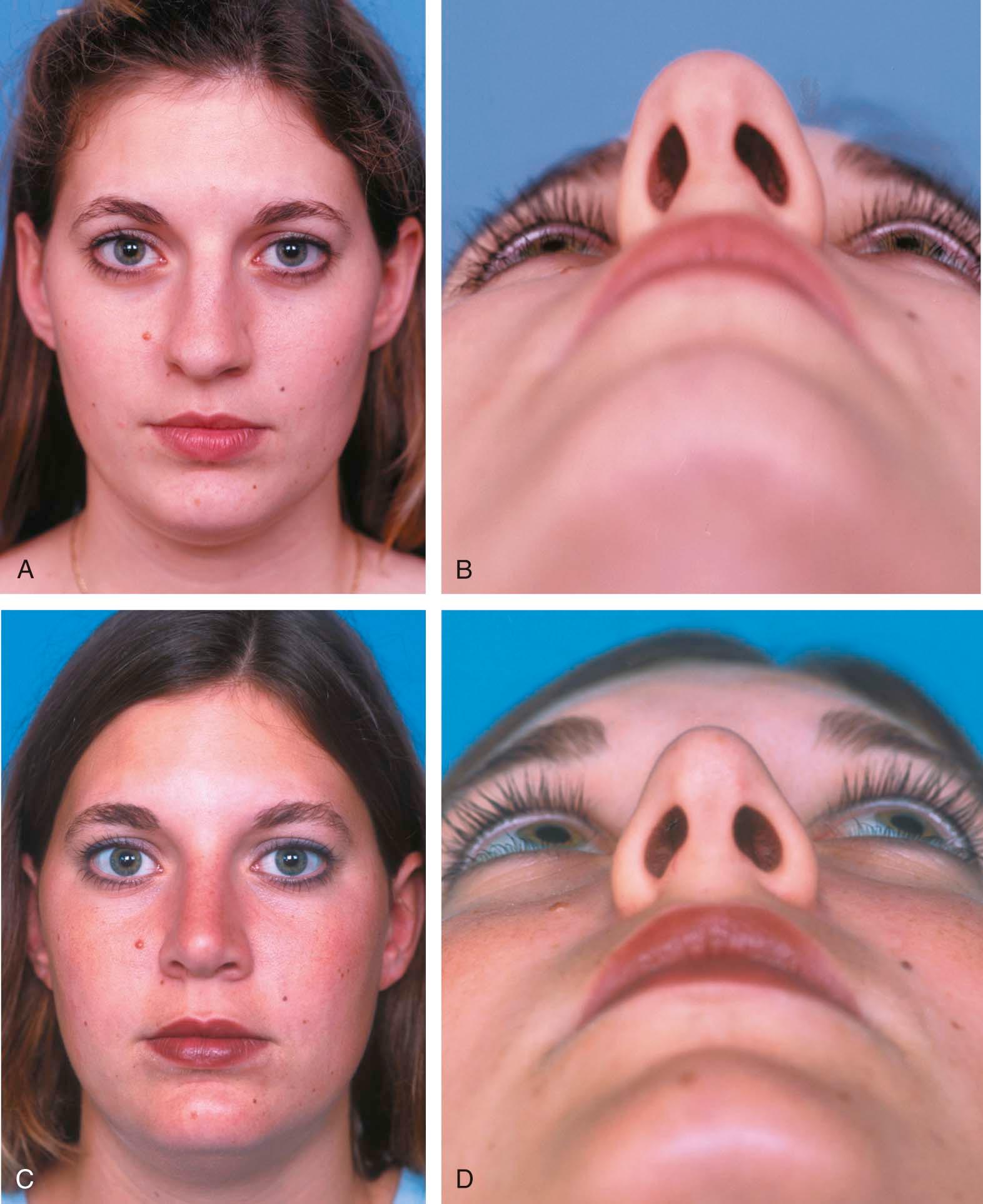
Become a Clinical Tree membership for Full access and enjoy Unlimited articles
If you are a member. Log in here